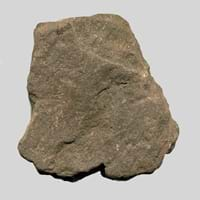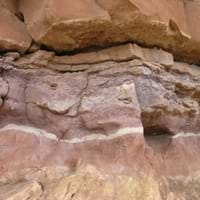Shale is a fine-grained sedimentary rock which is formed by the compaction of silt and clay-size mineral particles 0
From German Schalstein laminated limestone, and Schalgebirge layer of stone in stratified rock. From Old English scealu in its base sense of- thing that divides or separate, 0
Durable Rock, Medium Hardness Rock 0
Fine Grained Rock, Opaque Rock 0
Black, Brown, Buff, Green, Grey, Red, Yellow 0
Decorative Aggregates, Homes, Interior Decoration 0
As Building Stone, As Facing Stone, Office Buildings 0
Cement Manufacture, Construction Aggregate, for Road Aggregate, Making natural cement, Raw material for the manufacture of mortar 0
Creating Artwork, Pottery 0
Red Shale, Black Shale, Green Shale, Grey Shale and Yellow Shale 0
Easily splits into thin plates, Generally rough to touch, Very fine grained rock 0
Archaeological Significance
0
Shale forms when very fine-grained clay particles are deposited in water which settle at the bottom of water bodies. They are later compacted hence forming shale. 0
Albite, Biotite, Calcite, Chert, Chlorite, Dolomite, Hematite, Micas, Muscovite or Illite, Pyrite, Quartz, Silica, Sulfides 0
Ca, Fe, Mg, Silicon Dioxide, Sodium 0
Biological Weathering, Chemical Weathering, Mechanical Weathering 0
Chemical Erosion, Coastal Erosion, Glacier Erosion 0
Heat Resistant, Impact Resistant 0
Deposits in Eastern Continents
0
Bangladesh, China, India, Russia 0
Ethiopia, Kenya, Morocco, South Africa, Tanzania 0
Austria, France, Germany, Greece, Italy, Romania, Scotland, Spain, Switzerland 0
Deposits in Western Continents
0
Bolivia, Chile, Colombia, Ecuador, Peru, Venezuela 0
Deposits in Oceania Continent
0
New South Wales, New Zealand, Queensland, Victoria, Western Australia 0
Learn more about Properties of Shale
What is Shale? In this section, we will learn more about properties of Shale i.e. physical and thermal properties. Physical properties of Shale include Color, Streak, Hardness, Structure, Cleavage, Fracture, Luster, Specific Gravity etc. The strength of Shale is 95.00 N/mm2. Streak of Shale is white while its cleavage is slaty. Luster of Shale is dull and its fracture is not available. Shale is opaque in nature. Know all about Shale, What is Shale, its composition, features, facts and reserves in next sections.
Know about Composition of Shale
What is Shale composed of? Get to know about composition of Shale here. Shale definition gives information about the Formation of Shale and its composition.The composition of Shale can be further divided into mineral and compound content. The mineral content of Shale rock includes Albite, Biotite, Calcite, Chert, Chlorite, Dolomite, Hematite, Micas, Muscovite or Illite, Pyrite, Quartz, Silica, Sulfides and The compound content of Shale rock includes Ca, Fe, Mg, Silicon Dioxide, Sodium. Almost all rocks undergo transformation process. Know all about Shale rock in next section.









